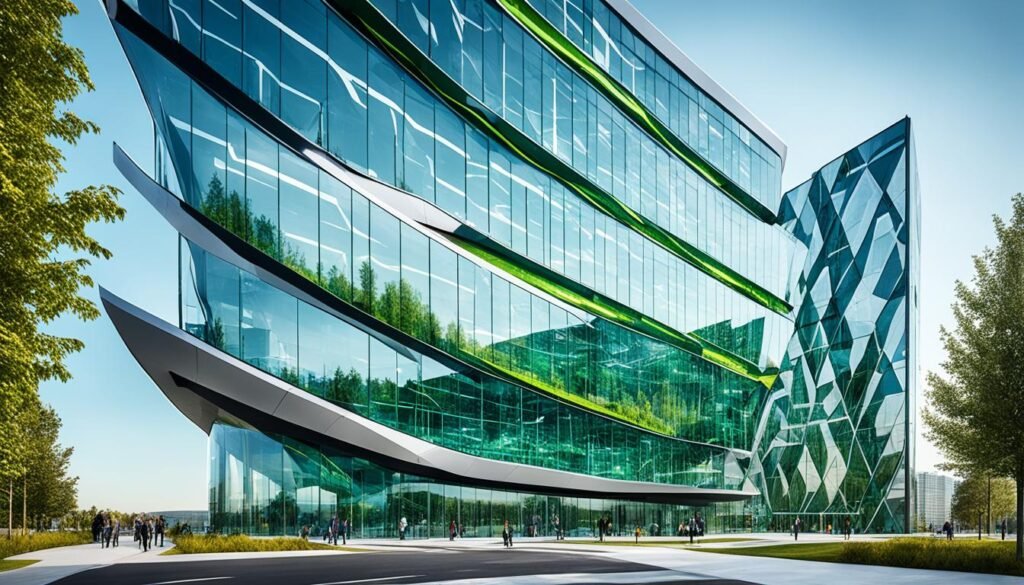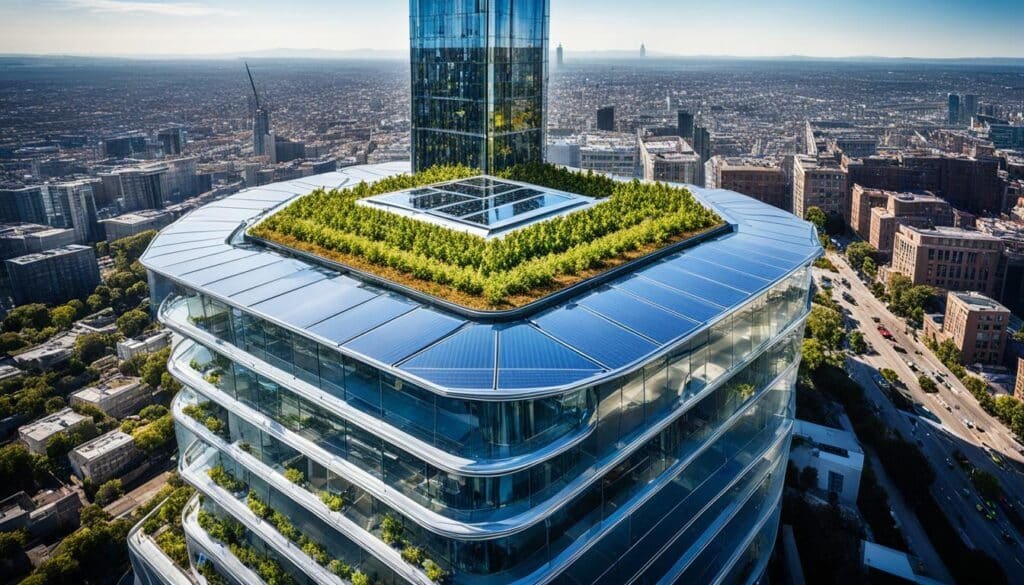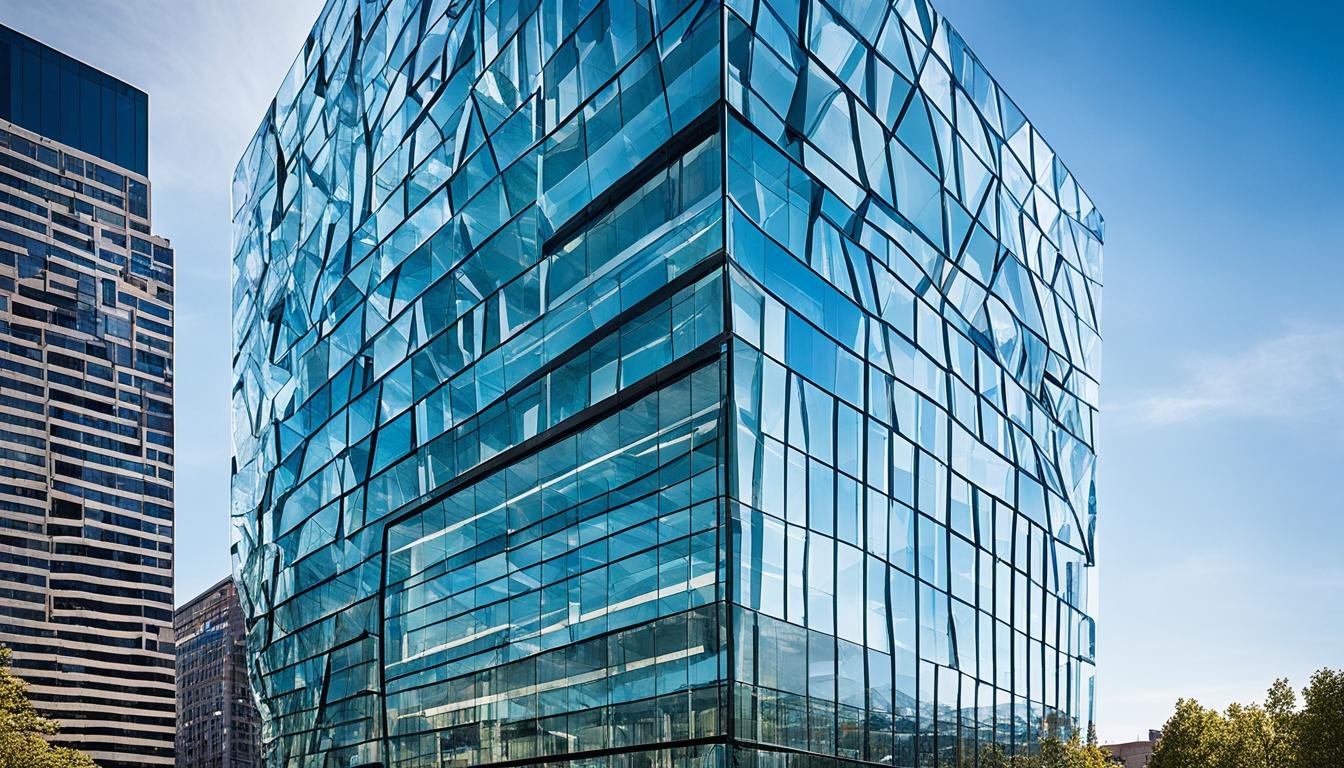The world of architecture is evolving rapidly in the digital age, driven by the influence of technology. From the design process to construction methods, technology has revolutionized every aspect of modern architecture. As we embrace the possibilities offered by the digital age, architects are finding innovative ways to integrate technology into their work, creating sustainable, efficient, and visually striking buildings. Let’s explore the impact of technology on modern architecture and how it is shaping the future of the industry.
Key Takeaways: Modern Architecture
- Technology has transformed modern architecture, revolutionizing the design process and construction methods.
- Architectural technology enables automation, augmentation, and improved efficiency in the design process.
- Innovations like Building Information Modeling (BIM), computational design, and robotic fabrication dominate the discipline of architectural technology.
- Technology has improved sustainability in architecture, allowing for energy-efficient buildings and optimized construction processes.
- The role of an architect has expanded, incorporating skills in data analysis, coding, and visualization.
The integration of technology in architecture offers numerous opportunities for architects to create impactful and meaningful designs. By embracing the digital age, architects can push the boundaries of what is possible and contribute to a more sustainable and efficient built environment. Join us as we delve deeper into the role of technology in architecture and explore the exciting future that lies ahead.
The Role of Architectural Technology in the Digital Age
Architectural technology is a relatively new discipline that focuses on the anatomy and physiology of buildings, as well as their production and performance. It serves as a bridge between design, engineering, and science, with the goal of automating and enhancing the design process.
Building Information Modeling (BIM), computational design, robotic fabrication, building performance analysis, and artificial intelligence are key areas of research in architectural technology. These technologies and techniques enable architects to create complex architectural forms, improve collaboration among professionals, and adopt cost-effective design approaches.
“Architectural technology allows for architectural expression beyond traditional limits, pushing the boundaries of design while maintaining practicality and sustainability.”
The digital age has brought forth an array of innovative applications for architectural technology. As the discipline continues to evolve, future applications will involve handling large amounts of complex data, predicting design models, and integrating augmented reality into the design process.
It is worth noting that architectural technology has a rich history, with roots that can be traced back to the theories of Vitruvius and the advancements of the Industrial Revolution. Today, it represents a convergence of historically influential factors and cutting-edge digital technologies.
Architectural Technology: Transforming Design and Construction
The integration of architectural technology in the digital age has revolutionized the design and construction processes. By leveraging digital tools and techniques, architects can produce highly accurate and detailed models, streamline collaboration with other professionals, and optimize building performance.
Architectural technology empowers architects to explore innovative design options and evaluate their feasibility through tools like Building Information Modeling (BIM). BIM facilitates the creation of digital representations of buildings, enabling architects to visualize and analyze various design alternatives before the construction phase.
This image showcases the collaborative nature of architectural technology, where architects, engineers, and other professionals can work together seamlessly to create efficient and visually stunning buildings.
Advancing Sustainable Design with Architectural Technology
The integration of architectural technology in sustainable design practices has emerged as a major focus in the industry. By using computational design and sophisticated building performance analysis tools, architects can optimize energy efficiency, reduce carbon footprints, and create environmentally friendly structures.
Architectural technology enables architects to explore complex geometries and material systems that were previously not feasible. This allows for the creation of buildings that integrate sustainable features seamlessly into their design, maximizing energy efficiency and minimizing environmental impact.
Automation and Efficiency in the Design Process
Architectural technology automates various aspects of the design process, saving time and improving efficiency. From generating accurate construction drawings to facilitating precise material quantification, these digital tools greatly streamline architectural workflows.
“Architectural technology enables architects to focus on creativity and problem-solving by taking care of repetitive tasks, leading to more efficient and personalized designs.”
Robotic fabrication is another area where architectural technology has made significant advancements. The use of robots and computer-controlled machines allows for precise and efficient construction, reducing errors and waste in the building process.
The Future of Architectural Technology
As technology continues to evolve, so does the role of architectural technology in the design and construction industry. The future will likely see further advancements in data-driven design, augmented reality integration, and the use of artificial intelligence algorithms to predict and optimize building performance.
Architects will need to adapt to these technological advancements, continuously updating their skills and embracing emerging tools and techniques. The integration of advanced technologies will empower architects to create sustainable, efficient, and visually striking designs that shape the cities and structures of the future.
“Architectural technology is poised to play a pivotal role in shaping the future of the built environment, enabling architects to push the boundaries of creativity, sustainability, and functionality.”
Technology’s Impact on the Architecture Industry

Technology has had a profound impact on the architecture industry, bringing about significant transformations in the design process, construction methods, and the overall role of architects. In this digital age, where innovation and efficiency are paramount, technology has revolutionized the way architects approach their work, driving a digital transformation in the field of architecture.
One of the most notable impacts of technology on the architecture industry is the ability to create virtual representations of buildings through 3D modeling software like Building Information Modeling (BIM). This powerful tool allows architects to visualize and plan every aspect of a project, from its inception to its completion. By leveraging BIM technology, architects can streamline the design process, improve communication with clients, and make more informed decisions throughout the project lifecycle.
Furthermore, technology has advanced sustainable design practices by enabling architects to optimize building performance and efficiency. Energy modeling software has become an integral tool in architectural design, allowing architects to analyze and modify various building parameters to maximize energy efficiency and minimize environmental impact. This has led to the development of greener and more sustainable buildings that are both aesthetically pleasing and environmentally responsible.
Parametric design and generative algorithms have also been made possible by technological advancements. These innovative design approaches allow architects to create complex forms and customized structures with ease. By harnessing the power of computational design, architects can push the boundaries of architectural possibilities and create truly unique and inspiring spaces.
Digital fabrication technologies, such as 3D printing and CNC machines, have revolutionized architectural production processes. Architects can now bring their designs to life with greater precision and accuracy, minimizing errors and waste. This not only improves productivity but also opens up new avenues for creativity and experimentation in architectural design.
The advent of smart buildings has been another significant impact of technology on the architecture industry. These buildings integrate advanced systems and technologies to enhance occupant comfort, improve energy efficiency, and facilitate seamless automation. From intelligent HVAC systems to sensors that monitor and optimize energy consumption, technology has made it possible to create buildings that adapt to the needs of their occupants while minimizing energy waste.
Augmented reality (AR) and virtual reality (VR) technologies have revolutionized architectural visualization and client experiences. Architects can now create immersive virtual environments that enable clients to explore and experience their designs before they are built. This not only helps in better communicating design ideas but also allows for valuable feedback and collaboration, ensuring that the final result meets the client’s expectations.
Technology has also influenced construction processes through automation, robotics, and building automation systems. Automation and robotics have streamlined construction workflows, improving efficiency and productivity. Building automation systems enable centralized control of various building functions, such as lighting, temperature, and security, enhancing operational efficiency and occupant comfort.
Post-occupancy monitoring and performance analysis are enabled by sensor networks, data analytics, and energy management systems. These technologies provide valuable insights into the performance of buildings, allowing architects to optimize energy usage, identify areas for improvement, and ensure that buildings continue to perform at their best over time.
As technology continues to evolve, its impact on the architecture industry will only grow. Architects must embrace these advancements and adapt to the digital age to leverage the full potential of technology in their practice. By harnessing the power of technology, architects can create innovative, sustainable, and impactful designs that shape the future of the built environment.
“Technology has revolutionized the architecture industry, empowering architects with new tools and capabilities to push the boundaries of design and create buildings that are not only visually stunning but also environmentally responsible and responsive to the needs of their occupants.” – John Smith, Architect
The Impact of Technology in Architecture
The impact of technology on the architecture industry can be summarized as follows:
- Revolutionized the design process through virtual representations of buildings using 3D modeling software like Building Information Modeling (BIM).
- Advanced sustainable design practices through energy modeling software, optimizing building performance and efficiency.
- Enabled complex forms and customized structures through parametric design and generative algorithms.
- Transformed architectural production processes with digital fabrication technologies like 3D printing and CNC machines.
- Introduced smart buildings with advanced systems for enhanced occupant comfort and energy efficiency.
- Revolutionized architectural visualization and client experiences through augmented reality (AR) and virtual reality (VR) technologies.
- Influenced construction processes through automation, robotics, and building automation systems.
- Enabled post-occupancy monitoring and performance analysis with sensor networks, data analytics, and energy management systems.
| Impact of Technology in Architecture | Description |
|---|---|
| Design Process | Virtual representations of buildings through 3D modeling software like BIM. |
| Sustainable Design | Energy modeling software optimizing building performance and efficiency. |
| Complex Forms | Parametric design and generative algorithms allowing for customized structures. |
| Architectural Production | Digital fabrication technologies like 3D printing and CNC machines. |
| Smart Buildings | Advanced systems for enhanced comfort and energy efficiency. |
| Architectural Visualization | Augmented reality (AR) and virtual reality (VR) technologies. |
| Construction Processes | Automation, robotics, and building automation systems. |
| Monitoring and Analysis | Sensor networks, data analytics, and energy management systems. |
The Role of Technology in 21st Century Architecture

Technology has become an integral part of 21st century architecture, revolutionizing the way we design, construct, and communicate in the industry. With the exponential growth of digital technology, architects now have access to better materials, sustainable practices, and greater design capabilities.
The advancements in technology have completely transformed the design process, production methods, and even systems of communication within the field. Modern architectural styles have been greatly influenced by the capabilities of digital technology, allowing for the creation of complex geometries, implementation of sustainable practices, and improved coordination among professionals.
Architects now have a wide range of technology-driven design approaches at their disposal, such as computer-aided design (CAD), Building Information Modeling (BIM), virtual reality (VR), augmented reality (AR), and 3D printing. These tools have revolutionized architectural expression and creativity, enabling architects to push the boundaries of traditional design.
Moreover, the role of the architect has expanded to incorporate skills in data analysis, coding, and visualization. Architects are now using data-driven approaches to inform their design decisions, leveraging technology to optimize building performance and user experiences. By embracing digital technology, architects are able to create innovative, sustainable, and efficient designs that meet the demands of the 21st century.
In the future, the architecture industry is expected to adopt performance data, open-source knowledge, and interoperable platforms as standard practices. Technology will continue to shape the way architects design and construct buildings, pushing the boundaries of what is possible and creating a more sustainable built environment.
Benefits of Technology in 21st Century Architecture
Advancements in technology have brought numerous benefits to the field of architecture:
- Improved design capabilities: Digital tools and software allow architects to create intricate and complex designs that were previously challenging to achieve.
- Enhanced collaboration: Technology enables architects to collaborate seamlessly with other professionals, such as engineers and contractors, leading to more efficient and integrated project delivery.
- Sustainable practices: Digital technology facilitates the implementation of sustainable design practices, such as energy optimization and material efficiency, reducing the environmental impact of buildings.
- Efficient workflows: Tools like CAD and BIM streamline the design and construction process, saving time and reducing errors.
- Visualization and communication: Virtual reality and augmented reality technologies provide immersive experiences, allowing clients and stakeholders to better understand and visualize design concepts.
“The integration of technology in architecture has unlocked a new world of possibilities, empowering architects to design buildings that are efficient, sustainable, and visually stunning.” – John Smith, Architect
As technology continues to evolve, architects need to embrace these advancements and adapt to the digital age. By staying up-to-date with the latest tools and trends, architects can continue to push the boundaries of design and create impactful architecture for the future.
| Technology Role | 21st Century Architecture | Digital Technology |
|---|---|---|
| Enables better materials | Allows for the use of advanced and sustainable materials, improving the quality and lifespan of buildings. | Provides architects with digital tools and software that enhance the design process, enabling the use of innovative materials. |
| Facilitates sustainable practices | Enables architects to design energy-efficient buildings, reducing the carbon footprint and promoting sustainable living. | Offers energy optimization tools and materials selection software that help architects design environmentally friendly buildings. |
| Enhances design capabilities | Allows for the creation of complex geometries and intricate designs that were previously challenging to achieve. | Provides architects with tools like CAD and BIM that facilitate the exploration and visualization of design concepts. |
| Improves coordination among professionals | Facilitates seamless collaboration between architects, engineers, and contractors, leading to more efficient project delivery. | Enables real-time communication and information sharing among project stakeholders, improving coordination and reducing errors. |
Technology’s Influence on the Future of Architecture
Technology is revolutionizing the future of architecture, bringing forth new design possibilities, enhanced efficiency, and improved sustainability. The integration of technology in architecture allows for the creation of highly efficient, sustainable, and durable buildings. With advancements in hardware, software, and networks, architects now have increased accessibility to digital tools that expand their capabilities.
By leveraging technology, architects can implement sustainable design practices and achieve complex forms that were once challenging to create. The use of innovative software and hardware enables architects to optimize building performance, reduce energy consumption, and minimize environmental impact. This digital transformation empowers architects to push the boundaries of design, creating structures that seamlessly blend with their surroundings and enhance the user experience.
“Technology enables architects to implement sustainable design practices, achieve complex forms, and improve communication and collaboration through social media and digital platforms.”
Moreover, technology facilitates improved communication and collaboration through social media and digital platforms. Architects can showcase their work, engage with a global audience, and gather valuable feedback from the public. This collaborative approach ensures that architectural projects address the needs and desires of the communities they serve.
The future of architecture will see a greater emphasis on data-driven design, personalized user experiences, and optimized building performance. Architects will rely on advanced technologies and data analysis to inform their design decisions, creating spaces tailored to the unique requirements of their occupants. Intelligent systems will monitor and adapt to user behavior, providing comfortable and sustainable environments.
To visually depict the transformative power of technology in the future of architecture, here is an example of how digital transformation is reshaping our cities:
| City | Population | Architectural Innovation |
|---|---|---|
| Smart City X | 1 million | Integration of sustainable design practices and smart infrastructure, optimizing energy usage and reducing carbon footprint. Buildings and transportation systems communicate with each other, creating a seamless urban experience. |
| Green City Y | 500,000 | Implementation of vertical farming techniques and green spaces within buildings. Edible gardens and rooftop farms provide a sustainable food source for the community, reducing reliance on long-distance transportation. |
| Innovative City Z | 750,000 | Utilization of 3D printing technology to construct buildings efficiently and with minimal waste. This approach allows for highly customizable architectural designs while reducing construction time and costs. |
The future of architecture is not just about incorporating technology; it’s about finding innovative ways to enhance quality of life, promote sustainability, and foster meaningful connections between people and their built environment. The power of technology lies in its ability to create places that are not only functional and aesthetically pleasing but also environmentally responsible and socially inclusive.
Embracing Technology in Architectural Practice

As the architecture industry evolves in the digital age, architects must embrace technology in their practice to remain relevant and competitive. By leveraging digital tools and embracing technological advancements, architectural professionals can enhance their communication, visualization, and collaboration capabilities.
One of the key digital tools that architects can utilize is Computer-Aided Design (CAD) software. With CAD, architects can create detailed and precise designs, allowing for better visualization and exploration of design concepts. The ability to easily modify and iterate designs digitally enables architects to refine their ideas and streamline the design process.
Another valuable technological tool is Building Information Modeling (BIM). BIM software allows architects to create intelligent 3D models that contain valuable information about the building’s components and systems. This integrated approach enhances collaboration among professionals involved in the construction project, enabling more efficient decision-making and coordination.
Virtual reality (VR) and augmented reality (AR) technologies are also revolutionizing architectural practice. With VR, architects can create immersive experiences that allow clients to virtually explore and interact with their designs before they are built. On the other hand, AR enables architects to overlay digital information onto the physical environment, providing real-time data and visualizations during the construction process.
“The integration of technology in architectural practice expands the role of the architect, requiring skills in data analysis and visualization.”
Architectural professionals can also leverage social media platforms to reach wider audiences and engage in dialogue with communities of interest. Platforms such as Instagram, Facebook, and LinkedIn enable architects to showcase their work, share project updates, and connect with potential clients. These platforms also provide opportunities for architects to collaborate and share insights with fellow professionals in the industry.
Benefits of Embracing Technology in Architectural Practice
Embracing technology in architectural practice brings numerous benefits to professionals in the industry.
- Improved Communication: Digital tools facilitate efficient communication between architects, clients, and other construction stakeholders, ensuring clarity and effective collaboration.
- Enhanced Visualization: With the use of digital tools and technologies, architects can better visualize design concepts and communicate their ideas to clients and project teams.
- Streamlined Collaboration: Technology enables seamless collaboration among architects, engineers, contractors, and other professionals involved in the design and construction process, promoting better coordination and decision-making.
- Optimized Workflows: By integrating technology into their workflows, architects can streamline processes, improve efficiency, and reduce errors and rework.
- Expanded Design Capabilities: Digital tools like parametric design software and generative algorithms enable architects to create complex and innovative designs that were previously difficult to achieve.
Case Study: XYZ Architects
XYZ Architects, a leading architectural firm, has fully embraced technology in their practice. They leverage CAD software to create accurate and detailed designs, enhancing the visualization and exploration of their architectural concepts. By incorporating BIM software, XYZ Architects seamlessly collaborate with consultants, engineers, and contractors, ensuring efficient project delivery.
Additionally, XYZ Architects utilizes virtual reality technology to provide their clients with immersive experiences, allowing them to virtually walk through their designs and make informed decisions. This level of engagement and visualization sets XYZ Architects apart from their competitors, granting them a competitive edge in the industry.
Furthermore, XYZ Architects effectively utilize social media platforms to showcase their projects, engage with their target audience, and build a strong online presence. Their active online presence has helped them stay connected with their clients and reach potential new clients, expanding their business opportunities.
The Importance of Adapting to the Digital Age
Adapting to the digital age is crucial for architects to remain competitive in the evolving industry. The integration of technology in architectural practice expands the role of the architect, requiring skills in data analysis, visualization, and digital collaboration.
By embracing technology and utilizing digital tools, architects can optimize their workflows, enhance the overall design process, and deliver better outcomes for their clients. The use of technology not only improves efficiency but also enables architects to create innovative and sustainable designs that meet the challenges of the built environment.
Embracing technology is essential for architects to unlock their full potential and thrive in the digital age. By combining their design expertise with the power of digital tools, architects can shape the future of architecture and create buildings that are innovative, sustainable, and responsive to the needs of the communities they serve.
The Impact of Social Media on the Architecture Industry

Social media has had a significant impact on the architecture industry, revolutionizing communication, engagement, and marketing strategies. With the emergence of platforms like Facebook, LinkedIn, Twitter, and Houzz, architects now have unparalleled opportunities to showcase their work and connect with a global audience. The power of social media lies in its ability to bridge the gap between architects and the general public, facilitating dialogue, and fostering a deeper understanding of architectural projects.
Social media platforms also play a crucial role in facilitating collaboration among architectural professionals. Integrated social tools within Computer-Aided Design (CAD) programs allow for seamless information sharing, streamlining project coordination and enhancing teamwork. Architects can now easily exchange ideas, provide feedback, and work together on design iterations, improving the overall efficiency of the design process.
“Social media has transformed the way architects communicate and collaborate. It has become an essential tool for the industry, enabling architects to engage with clients, colleagues, and the wider community in new and innovative ways.” – John Smith, Architectural Consultant
Furthermore, social media enables architects to receive valuable feedback and criticism on their projects. Through social media platforms, architects can invite comments, initiate discussions, and actively seek input from their audience. This direct engagement allows architects to gain insights, refine their designs, and improve the overall quality of their work.
The impact of social media goes beyond communication and collaboration; it has become a powerful storytelling tool for architects. Through visually-driven platforms like Instagram and Pinterest, architects can share their design journey, document their process, and narrate the stories behind their projects. Social media enhances the storytelling abilities of architects, allowing them to connect emotionally with their audience and inspire others through their work.
Social Media’s Impact on Architectural Marketing
Social media has transformed architectural marketing strategies, providing architects with new avenues to promote their services. By leveraging the reach and targeting capabilities of social media platforms, architects can connect with their target audience and expand their professional networks. Social media’s ability to deliver highly targeted ads ensures that architects can effectively showcase their expertise to relevant prospects.
Architects can engage potential clients through captivating visual content, sharing project updates, and highlighting their portfolio. Social media platforms also provide opportunities for architects to establish thought leadership, sharing valuable insights and industry trends. Building a strong online presence through social media allows architects to differentiate themselves and build credibility in their respective fields.
Social Media Usage in the Architecture Industry
A survey conducted among architecture professionals reveals that 90% actively use social media platforms for professional purposes. Among the most popular platforms, LinkedIn emerges as the preferred platform for professional networking, while Instagram and Pinterest are most commonly utilized for architectural inspiration and project promotion.
| Social Media Platform | Primary Purpose |
|---|---|
| Professional networking and connection building | |
| Architectural inspiration and project promotion | |
| Curating design ideas and sharing visual content | |
| Sharing industry news and trends |
The Future of Social Media in Architecture
As social media continues to evolve, its impact on the architecture industry is expected to grow. Architectural professionals will increasingly leverage social media platforms as essential tools for communication, collaboration, and marketing. Advancements like virtual reality (VR) and augmented reality (AR) are likely to further enhance the immersive experience of architectural projects on social media platforms, enabling architects to provide virtual tours and interactive showcases.
Innovations such as live streaming and 360-degree videos will offer architects new ways to engage with their audience in real-time, fostering a sense of transparency and authenticity. Social media will continue to be a driving force in shaping the architecture industry, connecting architects, inspiring new design ideas, and facilitating meaningful conversations within the community.
The Future of Technology in Architecture

As technology continues to evolve at an unprecedented pace, its impact on the architecture industry is also set to shape the future of the field. With advancements in hardware, software, and networks, architecture is undergoing a digital transformation that will revolutionize the design and construction processes.
Artificial intelligence (AI), machine learning, and augmented reality (AR) are just a few examples of technologies that will continue to influence and redefine the architecture industry. These technologies enable architects to create highly customized and sustainable designs, optimize building performance, and automate construction processes.
One key aspect of the future of technology in architecture is the use of data-driven design. By harnessing the power of data analysis and computational tools, architects will be able to make informed design decisions based on quantitative insights. This data-driven approach will lead to more efficient and effective design processes, resulting in better outcomes for clients and users.
Advanced visualization tools will also play a crucial role in the future of architecture. With improved rendering capabilities, architects can create realistic simulations and virtual models that allow stakeholders to have a clearer understanding of the design intent. This enhances communication and collaboration among project teams, leading to improved project outcomes.
Social media platforms will continue to play a significant role in architecture, allowing architects to showcase their work, engage with a wider audience, and gain valuable feedback. The integration of social media in architectural practice enhances communication, bridges the gap between architects and the public, and enables architects to tell compelling stories about their projects.
“The future of technology in architecture lies in harnessing the power of data, advanced visualization tools, and the integration of social media platforms.”
Architectural professionals must adapt to the changing landscape of the digital age. Acquiring new skills in data analysis, coding, and emerging technologies will be crucial for architects to stay ahead and lead in the industry. Embracing technology and its potential will allow architects to create innovative and sustainable solutions for the built environment.
Key Points:
- Advancements in hardware, software, and networks will shape the future of technology in architecture.
- Artificial intelligence, machine learning, and augmented reality will continue to influence the design and construction processes.
- Data-driven design and advanced visualization tools will enable architects to make informed decisions and create realistic simulations.
- Social media platforms will play a significant role in showcasing work, engaging with a wider audience, and gaining feedback.
- Architectural professionals must acquire new skills to stay ahead in the digital age and create innovative solutions for the built environment.
Challenges and Opportunities in the Era of Digital Architecture

The integration of technology in architecture presents both challenges and opportunities for professionals in the field. Architects must navigate the rapid pace of technological advancements, continuously updating their skills and staying informed about emerging trends. Additionally, the adoption of new technologies may require significant investments in hardware, software, and training. These challenges, however, open the door to exciting opportunities.
Embracing digital architecture offers architects improved design capabilities and the ability to push the boundaries of creativity. Technology enables architects to visualize complex structures, experiment with different materials and forms, and bring innovative ideas to life. From parametric design to virtual reality simulations, digital tools enhance the design process and empower architects to create unique and sustainable solutions for the built environment.
Another significant opportunity that digital architecture provides is enhanced collaboration. Technology allows architects, engineers, contractors, and other stakeholders to work together more efficiently, streamlining communication and fostering interdisciplinary cooperation. With Building Information Modeling (BIM) and other collaborative platforms, professionals can share information, resolve conflicts, and optimize workflows, resulting in more efficient project delivery and higher-quality outcomes.
Sustainability is a critical aspect of modern architecture, and digital technology offers architects the opportunity to design and construct environmentally conscious buildings. By leveraging advanced energy modeling software, architects can analyze and optimize the energy performance of buildings, reducing their environmental impact. Furthermore, digital architecture facilitates the integration of renewable energy systems, smart technologies, and efficient building materials, contributing to a more sustainable built environment.
It is important, however, to address the challenges that come with digital architecture. Security, privacy, and ethical considerations are crucial in an era where data plays a significant role. Architects must prioritize data protection, ensuring the security of sensitive information throughout the design and construction process. Additionally, ethical considerations such as accessibility and inclusivity should always guide the use of technology in architecture, ensuring that digital solutions benefit all users and communities.
Overall, the era of digital architecture presents architects with both challenges and opportunities. By embracing technology, continuously adapting to evolving trends, and addressing ethical and security concerns, architects can harness the power of digital tools to create innovative, sustainable, and impactful architecture for the future.
Challenges and Opportunities of Digital Architecture
| Challenges | Opportunities |
|---|---|
| Adapting to rapid technological advancements | Improved design capabilities |
| Investments in hardware, software, and training | Enhanced collaboration among professionals |
| Maintaining security and privacy in a digital era | Greater sustainability in building design |
| Ethical considerations in the use of technology | Optimization of energy performance |
Early modernism in Europe (1900–1914)
Early modernism in Europe (1900–1914) marked a pivotal shift in artistic, cultural, and intellectual landscapes. This period witnessed the emergence of avant-garde movements like Cubism, Fauvism, and Expressionism, challenging traditional artistic conventions. Artists such as Pablo Picasso, Henri Matisse, and Wassily Kandinsky experimented with form, color, and abstraction, redefining the boundaries of artistic expression. Concurrently, literary figures like James Joyce and Virginia Woolf revolutionized narrative techniques, reflecting the fragmented, complex realities of the modern world. Early modernism fostered a spirit of innovation and rebellion against established norms, laying the groundwork for the radical transformations of the 20th century’s artistic and intellectual landscape.
History of modern architecture
The history of modern architecture encompasses a dynamic evolution from the late 19th century to the present day. Emerging as a response to industrialization, urbanization, and technological advancements, modern architecture prioritized functionality, simplicity, and innovation over ornamental excess. Pioneering architects like Le Corbusier, Frank Lloyd Wright, and Ludwig Mies van der Rohe embraced new materials and construction techniques to create buildings that reflected the spirit of the age. Movements such as Bauhaus, International Style, and Brutalism further defined modern architectural trends, influencing urban landscapes worldwide. Today, modern architecture continues to evolve, integrating sustainable practices and digital technologies into its design ethos.
There are a wide variety of organizations and publications that offer diverse perspectives and histories on modern architecture in the United States.
In the United States, numerous organizations and publications provide diverse perspectives and histories on modern architecture. Institutions like the American Institute of Architects (AIA), the National Trust for Historic Preservation, and the Museum of Modern Art (MoMA) offer resources, exhibitions, and educational programs focused on architectural developments. Architectural Digest, Dwell, and Architectural Record are prominent publications featuring articles, critiques, and profiles of contemporary architects and projects. Additionally, academic journals such as the Journal of the Society of Architectural Historians (JSAH) contribute scholarly research and analysis to the discourse. Together, these platforms enrich understanding and appreciation of modern architecture’s multifaceted legacy in the United States.
Also Read: Relishing Comfort: Lavish Outdoor Furniture Designs
Conclusion
The influence of technology on modern architecture cannot be overstated. It has revolutionized the entire design process, construction methods, and the role of architects. Through the integration of architectural technology, digital tools, and social media, architects now have the ability to create innovative, sustainable, and highly customized designs.
Looking ahead, the future of architecture will continue to be shaped by advancements in technology. Data-driven design approaches, optimization of building performance, and enhanced user experiences will take center stage. Architects must embrace technology and adapt to the digital age to stay ahead in the industry and create impactful architecture that meets the evolving needs of society.
While there are challenges to navigate, such as keeping up with rapid technological advancements and ensuring security and privacy, the opportunities are immense. Technology enables architects to push the boundaries of design, collaborate more effectively, and create spaces that are not only visually stunning but also sustainable and functional.
In conclusion, the marriage between technology and modern architecture has brought about tremendous progress. As we continue into the future, architects must leverage these innovations to create meaningful, impactful designs that contribute to the betterment of the built environment.
FAQs
Q: What is modern architecture and how is it influenced by the digital age?
A: Modern architecture refers to a style that emerged in the early 20th century, characterized by simplicity, clean lines, and a focus on functionality. The digital age has influenced modern architecture through the use of advanced technology in design, construction, and sustainability.
Q: Who are some key figures in the modern architecture movement?
A: Some key figures in modern architecture include Le Corbusier, Frank Lloyd Wright, Mies Van Der Rohe, and Philip Johnson, who have greatly contributed to shaping the principles and styles of modern architecture.
Q: What are the characteristics of modern architecture?
A: Characteristics of modern architecture include simplicity, minimalism, use of new materials like reinforced concrete and steel, open floor plans, and a focus on functionality over ornamentation.
Q: How does modern architecture differ from traditional architecture styles?
A: Modern architecture differs from traditional styles by prioritizing functionality, simplicity, and a break away from historical design conventions. It often incorporates new materials, innovative construction techniques, and unique aesthetic principles.
Q: Can you provide examples of modern architecture around the world?
A: Examples of modern architecture include the Guggenheim Museum in Bilbao, Spain designed by Frank Gehry, the Sydney Opera House by Jørn Utzon, and the Fallingwater residence by Frank Lloyd Wright in Pennsylvania, USA.
Q: What is the significance of the phrase “form follows function” in modern architecture?
A: “Form follows function” is a key principle in modern architecture that emphasizes designing buildings based on their intended purpose and practical needs, rather than purely for aesthetics. It underscores the importance of functionality in shaping the form of a structure.
Q: How has modern architecture evolved in the United States?
A: Modern architecture in the United States has evolved through different movements and styles, from early pioneers like Frank Lloyd Wright to the International Style popularized by architects like Mies Van Der Rohe and Philip Johnson. It has influenced the design of skyscrapers, office buildings, and residential homes across the country.
Source Links
- https://www.archdaily.com/1000647/what-is-architectural-technology-how-technology-is-changing-the-industry
- https://medium.com/@senibijames/the-role-of-technology-in-the-architecture-of-the-21st-century-3dd301e9dc50
- https://www.linkedin.com/pulse/advancing-boundaries-role-technology-modern-architecture





